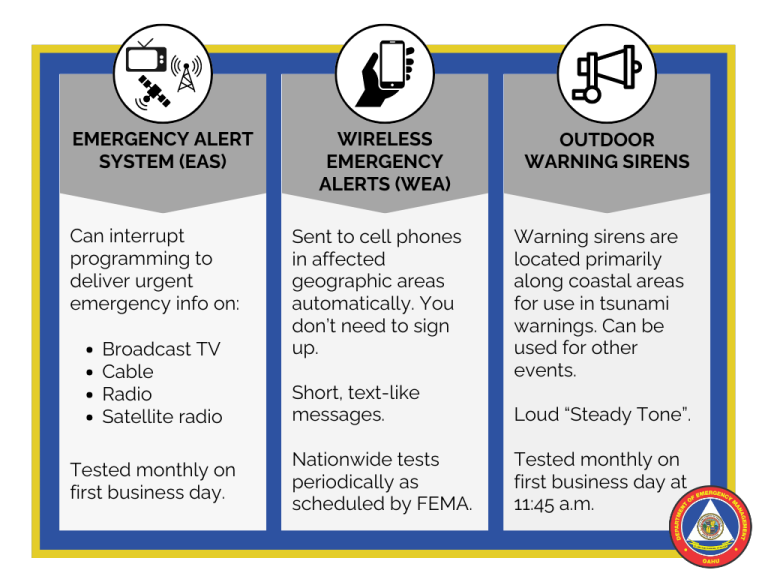Stay Informed- What you Need to Know
Understanding how you will be alerted to urgent emergency situations and where to go before, during and after disasters for other official, vetted information is a critical part of being prepared.
About Public Alert and Warning Systems
These are systems used to alert the public of immediate threats to public safety and deliver urgent life-saving information. In Hawaii, the public alert and warning system includes the Emergency Alert System, Wireless Emergency Alerts and the Outdoor Warning Sirens. Depending on the nature and severity of the emergency, one or all of these systems may be activated to alert the public.

Emergency Alert System (EAS)
The Emergency Alert System (EAS) is a national public warning system that state and local governments can use to interrupt regular programming and deliver urgent emergency information via TV, radio, cable and satellite services. The EAS can also be activated nationwide by the federal government to enable the President to address the public during a national emergency. EAS participants – radio and television broadcasters, cable systems, satellite radio and television providers, and wireline video providers – deliver state and local alerts on a voluntary basis, but they are required to deliver Presidential alerts. The majority of EAS alerts originate from the National Weather Service in response to severe weather events, but the counties or the state can also use the system to communicate urgent emergency instructions such as evacuation or shelter-in-place orders, or to issue AMBER alerts. FEMA and the FCC work collaboratively to maintain the Emergency Alert System and they establish standards and procedures for system use.
The EAS, along with the sirens, is tested by emergency management officials on the first business day of each month in collaboration with the Hawai’i Emergency Management Agency (HI-EMA) and local radio/TV/Cable broadcast partners. Broadcasters conduct additional weekly testing. National tests of the system are also conducted periodically by FEMA and the FCC.
Wireless Emergency Alerts (WEA)
Wireless Emergency Alerts (WEA) are another component of the national public warning system along with the Emergency Alert System (EAS). Wireless Emergency Alerts are short emergency messages sent by authorized federal, state or local government agencies through mobile carriers. A WEA alert appears on the screen of the recipient’s phone as a text-like message. The alert is accompanied by a unique attention signal and vibration, which is particularly helpful to people with hearing or vision-related disabilities.
These alerts are broadcast to the geographic area affected by an emergency. For example, WEA messages may be broadcast to all cell phones statewide, or targeted to only one island or even a specific area of an island. During national emergencies, alerts can be issued nationwide.
WEA messages can only be issued during critical emergency situations. There are four types of alerts:
- National alerts issued by the President of the United States or the Administrator of FEMA
- Amber Alerts about missing children
- Alerts involving imminent threats to safety or life (e.g. urgent weather warnings from the National Weather Services)
- Other Local Alerts conveying recommendations for saving lives and property (e.g. specific areas to evacuate)
There is no sign-up required to receive these messages and there is no cost involved. You will automatically receive WEA messages as long as you have a WEA-capable mobile phone that is turned on, and in the vicinity of a cell tower of a wireless carrier that participates in WEA.
Outdoor Warning Sirens

A third prong of the public alert and warning system is the Statewide Outdoor Siren System, which may be activated by counties or the state at the same time they issue EAS and WEA messages deliver urgent emergency information. The primary function of the sirens is to alert the public that there is an urgent hazard that requires immediate attention. When you hear this ‘Steady Tone’, tune into local radio, TV or other official online media right away to get official information and instructions.
Sirens will not sound in every emergency situation. Sirens will sound island-wide during a tsunami warning or prior to a hurricane making landfall. Sirens may be used in localized areas for other emergency situations to alert people to tune in and get emergency information when evacuation orders, shelter-in-place orders, or lifesaving messages are issued. However, sirens will only be activated if there are operational sirens in the affected area and if there is enough time to sound the sirens. The first priority for emergency officials will be activating the Emergency Alert System (EAS) and issuing Wireless Emergency Alerts (WEA) because those systems reach the most people and allow specific instructions to be communicated.
Outdoor Warning Sirens are installed and maintained by the State’s Hawaii Emergency Management Agency. Not all areas of the island are within range of a siren; costal tsunami evacuation zones are prioritized for siren placement.
Each county is able to operate the sirens within its jurisdiction and has primary responsibility for determining if and when to sound the sirens during an emergency. The Hawaii Emergency Management Agency (HI-EMA) is able to activate the sirens. In most cases, HI-EMA serves as a back-up to the county and will only activate the sirens at the request of the affected county. For Local Tsunami Warnings, however, because there is very limited time available to alert the public, HI-EMA is responsible for immediately activating all sirens statewide.
The sirens, along with the Emergency Alert System (EAS), are tested on the first business day of each month. Sirens are tested at 11:45 am in collaboration with the Hawaii Emergency Management Agency (HI-EMA) and local radio/TV/Cable broadcast partners. You can report whether or not a siren in your area successfully sounded during the monthly test by submitting a Month Siren Test Report.
Occasionally, additional siren testing is scheduled to ensure newly installed or repaired sirens are functioning properly.
Residents are notified of all siren tests via local television, radio and print media as well as by official social media and HNL.info alerts.
If you hear a siren sound and there is no emergency information being broadcasted over TV, radio, HNL.info, or official social media, it’s more than likely a malfunctioning unit.
Sirens are also equipped with a special Tamper Alert sound, which sounds like a Hi/Lo Tone, to warn when unauthorized access to the siren is occurring. Click here for a sample of what the Tamper Alert sounds like.
To report siren problems, malfunctions, or vandalism, call 911.
Smart Phone Alerts - HNL Info
HNL.Info is a free City app that sends messages to users via email, text or push alert. The Department of Emergency Management uses HNL.Info Alerts to provide weather and disaster related information, which includes both routine information, such as a National Weather Service watches or advisories for Oahu, and urgent alerts related to weather warnings or other disaster conditions. Users can also select to receive alerts on a range of other topics, such as road closures, beach conditions, or information about essential City services such as water main breaks.


Follow Official Social Media
During emergencies, it’s critical that you know where to get official, credible information about what’s happening. Here are some suggestions of social media sites to follow to stay informed.
DEM
City and County of Honolulu
HI-EMA
American Red Cross of Hawaii
National Weather Service
Hawaiian Electric
Board of Water Supply
Add a NOAA Weather Radio to Your Emergency Kit
NOAA Weather Radio All Hazards (NWR) is a nationwide network of radio stations broadcasting continuous weather information directly from the nearest National Weather Service office 24-hours a day. Severe weather warnings are immediately broadcast, as well as other public safety and emergency messages issued by local authorities via the Emergency Alert System (EAS).
Unlike typical transistor radios which only receive AM/FM stations, a NOAA Weather Radio is required to receive the NOAA Weather Radio All Hazards signal.
Units that receive the NOAA Weather Radio All Hazards signal are available at many electronic retail stores, marine supply stores, mail order catalogs and the Internet. Prices vary by model and available options, but typically range between $20 and $80.
Staying Informed After a Disaster
- If possible, monitor TV, radio, official social media, and HNL Info alerts to listen for further emergency information and special instructions.
- Save phone calls for emergencies only. Phone systems are often down or busy after a disaster.
- Use text messages or social media to communicate with family and friends.

